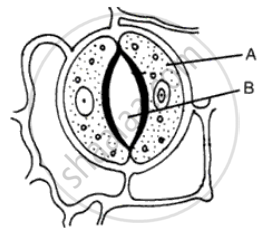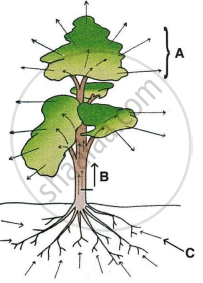Advertisements
Advertisements
Question
Why are the stomata in most plants more numerous on the lower surface of a leaf instead of being on the upper surface?
Solution
The lower surface of leaf is sheltered from direct sunlight. If more stomata are on the upper surface of a leaf, then excessive transpiration would occur, resulting in quick wilting of the plant. Hence most plants have more numerous stomata on the lower surface of a leaf to control the rate of transpiration.
APPEARS IN
RELATED QUESTIONS
Which of the following statements are true and which ones are false? Give reason in support of your answer.
Atmospheric humidity promotes transpiration from a green plant.
Which of the following statements are true and which ones are false? Give reason in support of your answer.
Some desert plants have sunked stomata on their leaves.
Answer the following (only in few words);
Where does transpiration take place in leaves? Give names of the various parts.
The diagram alongside represents a structure found in a leaf. Study the same and answer the questions that follow:
(i) Name the parts labeled A and B.
(ii) What is the biological term for the above structure?
(iii) What is the function of the part labeled A?
(iv) Mention two structural features of A, which help in the function mentioned in (iii) above?
(v) Where is this structure likely to be found in a leaf?
(vi) The structure (fig.5.22) helps in the process of transpiration. Explain the term transpiration.
(vii) How many other cells are found surrounding this structure as seen in the diagram?

Give Reasons for the following:
Balsam plants wilt during midday even if the soil is well watered.
Give Reasons for the following:
Forest bring in the rain, transpiration is the cause.
Explain the Term :
Wilting
Complete the following sentence with appropriate word:
Transpiration is the loss of water__________________from the leaves of the plant.
Column ‘II’ is a list of items related to ideas in Column ‘I’. Match the term in Column ‘II’ with a suitable idea given in Column ‘I’.
| Column I | Column II |
| (i) Transpiration | (a) Cacti plants |
| (ii) Movement of water | (b) Stomata |
| (iii) Guttation | (c) Maize plant |
| (iv) Low rate of transpiration | (d)Xylem |
| (v) The high rate of transpiration | (e) Hydathodes |
An outline sketch of a tree is shown in a diagram below. Study the same and answer the questions that follow:

- Name and define the phenomenon labelled A in the diagram.
- Write the significance of the process mentioned in A for the plants.
- What do the direction of the arrows in B and C indicate? Name the phenomena.
- Draw a neat and labelled diagram of an opened stomata.
